Skype, a VoIP program
The most popular, free VoIP program today is Skype. Skype and other VoIP programs are both client and server -- they are peer to peer programs.
|
Skype users can talk with each other across the Internet, and quality is generally very good. Here we see a telephone conversation between my wife and me. I was in my office at the university and she was at home.
Skype users can talk also talk with people on standard telephones by routing the call through a gateway connecting the public switched telephone network (PSTN) and the Internet. Skype and other gateway operators charge for that service.
Note that my wife has not placed a photo of herself in her user profile, so a generic silhouette is used. |

|
|
|
Here we see a conference call between myself, my wife and my brother-in-law at his home in Santiago, Chile. The quality was as good as a PSTN call.
Skype is a presence-aware program. A user can grant friends and colleagues permission to sense whether or not he or she is present (on-line and willing to accept calls). One can also be automatically notified by a small-popup "toast" message when a friend or colleague comes on line. This helps in establishing conference calls such as this one.
|

|
Since Skype is a standard Internet application at the edge of the network, programmers can add features to improve it whenever they want to. (If it were in the center of the network, only the network operator could add features). You may hear the Internet described as a dumb network -- all it can do is quickly transfer information between hosts connected to it -- but that is meant as a compliment, and was a central goal in the original design of the Internet. The designers of the Internet understood that innovation and investment would be much faster if it were in the hands of the user community than the network operators.
When Skype first came out, it could only handle two-party calls. Today, it can handle conference calls, a simultaneous text chat session, file transfer during a call, video calls and calls to the PSTN, and Skype programmers are doubtless working on new features.

